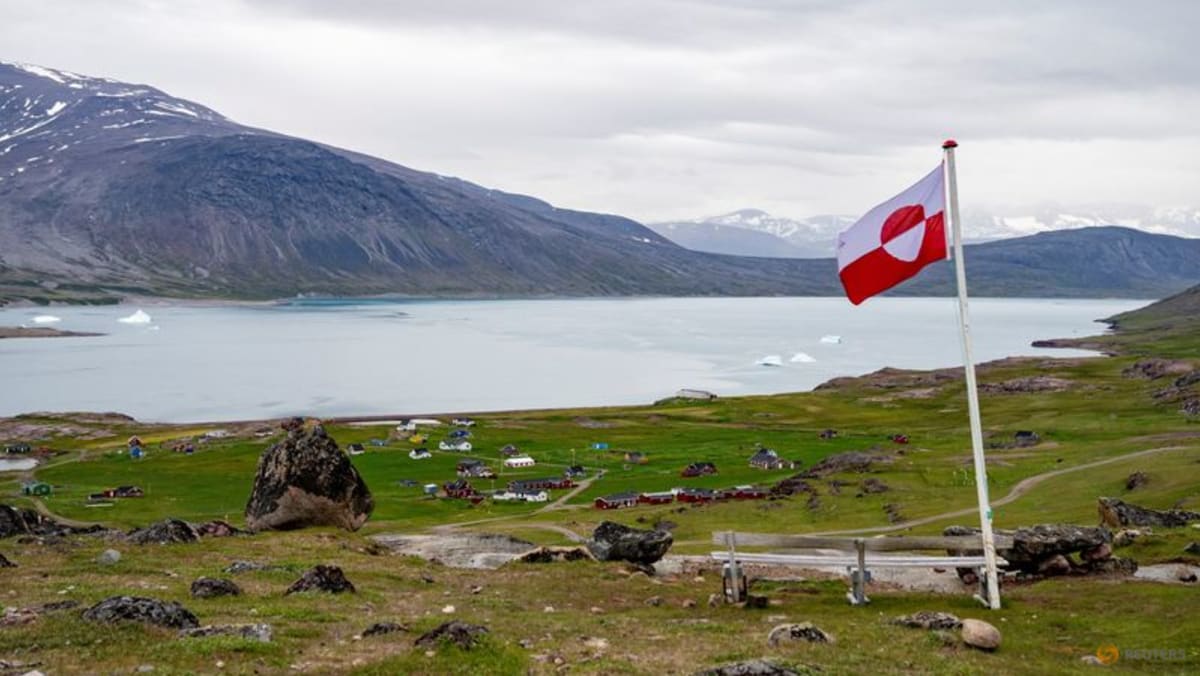National Route 52 in Cambodia ends in Chnok Tru on the southern end of Tonle Sap Lake. The village is a main transfer point for fish and vegetables. On a typical day, boats crowd the surface and people carry large plastic baskets ashore.
During the dry season, a concrete pole on the side of the road gives an idea of how different the area looks just a few months later during the rainy season. At about 4 metres (13 feet), the pole’s colour pales, indicating how high the water will rise.
Much of that water comes to Tonle Sap Lake through the Tonle Sap River, which takes water from the Mekong River in Phnom Penh during the annual rainfalls. The opposite happens in the dry season when the Tonle Sap River empties its namesake lake and carries water back to the Mekong.
The result is that every rainy season, Tonle Sap Lake grows five to six times larger to 15,000 square kilometres (5,791 square miles), with its length almost doubling to 220 (136 miles) and its depth increasing from about 1 metre (3 feet) to more than 9 metres (29 feet).
On satellite images, this cycle looks like a beating water heart connected to the Mekong as its main artery. The heart has been beating for thousands of years with a regularity that allowed the people to adapt to the floods by living in houses on stilts or floating.

But climate change and dams in the Mekong and its tributaries are increasingly threatening Tonle Sap Lake’s annual expansion and fish catch. The growing number of dams in the Mekong and tributaries upstream of the lake dampen the flood cycle by holding back water during the rainy season.
For the people living on or near the water, the regular muddy floods are a blessing, not a threat. They bring fish larvae and nutrients for shoreline farm crops and the plants that feed the lake’s growing fish.
“The Mekong needs its ups and downs, lots of water during the wet season and very little water during the dry season,” said Brian Eyler, a Southeast Asia expert at the Stimson Center, a think tank in Washington, D.C. “The whole ecosystem is tuned to those highs and lows. When the floods are really high, they scrape wood and sediment and bushes and grasses and rotting stuff into the river to contribute to this mix of nutrients that produces the explosion of fish and agricultural productivity.”
The nutrient-rich floods have turned Tonle Sap into one of the most productive and biodiverse lakes in the world with more than 200 species of fish. The annual fishing haul of at least 300,000 metric tonnes (330,693 U.S. tons) is about twice as much as the freshwater catches of Canada, Mexico and the United States combined, Eyler said.
“Cambodia has the most productive fisheries of any country in the Lower Mekong,” said Zeb Hogan, a fish expert at the University of Nevada, Reno, who leads the Wonders of the Mekong research project. “The Tonle Sap system drives most of that.”
That’s important because Cambodia is one of the world’s most freshwater fish-dependent countries by area and population, said Marc Goichot, the Asia and Pacific freshwater lead for the World Wildlife Fund, a conservation organisation.
Cambodians get more than half of their animal protein from fish, eating about 75 kilograms (165 pounds) per person annually, including three quarters sourced from Tonle Sap Lake. This is sustainable, Goichot added, because unlike agriculture, wild fish do not consume water, land, fertilisers or pesticides.
Potential heart attack
Climate change is at least partly responsible for increasingly drier rainy seasons in Cambodia, experts said. This was especially serious in 2019, 2020 and 2021 when monsoon rains came several weeks late and the Mekong carried unusually little water because of drought.
The Mekong’s 10 lowest flow years on record since 1910 included 2020 as the lowest, 2019 seventh and 2021 ninth lowest.
What’s more, the 86 biggest dams built in the Mekong basin by 2016 reduce water flow into the lake each year by 10 to 25%, shorten inundation of the lake’s periphery by two weeks, and shrink the inundated areas in the wet season by 245 square kilometres (94.5 square miles), according to a modelling study published in March by Yadu Pokhrel of Michigan State University and colleagues.
That doesn’t account for six of the now 13 hydropower dams on the Mekong mainstream in China and Laos that began operating after 2016. Together, these dams further reduced the Mekong’s already unusually low rainy season water flow, Eyler said, contributing to a shortening of the lake’s rainy season expansion by one month or more in 2019, 2020 and 2021.
Dams also trap much of the nutrient-rich sediment needed for fish and crop growth. China’s 11 Mekong dams alone hold back 60% of the sediment, Eyler estimated.
Climate change adds to the problem by reducing the number of tropical cyclones normally washing sediment from Vietnam’s mountains into the river, said geographer Chris Hackney of Newcastle University in England.
Less water and sediment mean fewer fish larvae and nutrients in Tonle Sap Lake, which affects fish catch. There is also an absence or delay of high water levels that fish need to spawn in the lake or migrate to spawning grounds in the upper reaches of the Mekong or tributaries.
“Every year the water keeps getting lower,” said Tonle Sap Lake fisherwoman Hay Sreang. “If the water is very low, there is no fish. We don’t know how to make a living. I am worried, I don’t know what to do in the future.”
That future doesn’t look good: Climate scientists predict the beginning and end of monsoon rains will move closer together due to climate change, Eyler said.
Dam construction on the Mekong continues. China is building a 12th hydropower dam with seven more planned. Laos is building a third and plans to build seven more, aiming to become the “battery of Southeast Asia” and sell the power from its dams to neighbouring Vietnam, Laos and Cambodia, Eyler said.
There are hundreds of additional dams on the Mekong’s tributaries found by Eyler and his team using satellite imagery, including many used for irrigation rather than power generation. They counted 400, mostly in Thailand but also in China, Laos and Vietnam; almost 400 more are under construction or planned, mostly in Laos, he said.
Construction of all the planned dams in the Mekong and its tributaries might eventually leave the Mekong’s waters with only 4% of its nutrient-rich sediment, Eyler warned.
Pokhrel and colleagues in 2018 calculated the Mekong’s maximum flow reduction needed to bring the lake’s annual expansion to a halt. Theoretically, they concluded, the frightening result could be achieved through just one mega-dam around the Sambor area in Cambodia.
The 2,600-megawatt, 18-kilometre (11-mile) dam originally planned near Sambor likely wouldn’t have been big enough to achieve this. But experts warned the dam, which has been postponed until 2030, would deal a death blow to fisheries in Tonle Sap Lake because it would block one of the Mekong basin’s most important migration routes for about 50 fish species.
The dam’s reservoir also could flood the homes of nearly 20,000 people. One of them is Phloak Sareth, who lives with her family on Tnaut Island in the Mekong near Sambor and has worried since 2007 that she might have to move because of the dam.
“If we were relocated, we would not be happy,” she said. On the island, she has enough fish, fertile soil and water to irrigate the vegetables even in the dry season, which might be unlikely at a new location. “What if we can’t get water or take a shower, especially during the dry season?”
She said the existing dams in the Mekong already dampen the all-important flood cycle farmers depend on because the water flow has not remained at the same consistency: “The river normally drops in February and March and rises in May and June. But because of the dams, the water floods our crops as early as February and March.”
“The problem I worry about most is the decreasing number of fish,” she said, adding that the dams could drive them into extinction.
While Cambodia doesn’t yet have dams in the Mekong mainstream, tributary dams are far from harmless. In 2018 Cambodia completed its biggest, the 400-megawatt Lower Sesan II dam. Standing 75 metres (246 feet) tall and stretching 6 kilometres (3.7 miles), the dam blocks the Sesan and Srepok rivers, two of the largest Mekong tributaries in Cambodia.
The dam keeps fish from migrating from the Mekong and Tonle Sap Lake to their spawning grounds, with serious consequences for fish yields, according to an August 2021 report by Human Rights Watch.
Fish catches upstream declined dramatically following the dam’s launch, resulting in lost income of $100 or $200 per month and higher costs for purchases of additional food. A canal built to allow fish migration around the dam often carries little water and is far from a sufficient substitute, according to the report.
The dam’s reservoir, covering about 300 square kilometres (116 square miles), flooded several villages, forcing about 860 families to move. As compensation, they each were offered a few hundred dollars, a small house with a field several kilometres from the river or $6,000 to build a house. About 800 families accepted.

But about 60 families refused and built new houses on land about a kilometre from the original site, including the family of Fut Kheun, who lost his home and vegetable field. “We don’t want to be far away from our ancestors’ graves buried under the flood,” Kheun said. “The idea for the new village is to make it like the old village.”
But the new location lacked clean water and teachers, preventing children from attending school for years. He said the government should use other ways to generate energy than building hydropower plants.
The capital and the sand
The famous flow reversal, where the Mekong rises so high during the rainy season that water flows into the Tonle Sap River instead of out, takes place at the Chaktomuk junction in the capital, Phnom Penh.
In this crucial spot, ships can often be seen staying put for hours or days. The vessels are mining sand, according to Hackney, who has counted them using satellite imagery.
On Cambodia’s southernmost, 150-kilometre (93-mile) stretch of the Mekong, which includes Phnom Penh, Hackney counted a daily average of about 50 ships in 2016; by 2020, the average was 120.
The 2020 figure translates into around 59 million metric tonnes of sand (about 65 million U.S. tons) being extracted from the Mekong each year in Cambodia alone, almost 10 times the 6 million metric tonnes (6.6 million U.S. tons) the river carries annually.
This means the riverbed between Kampong Cham in Cambodia and the Mekong River delta in Vietnam is sinking by about 10 centimetres (3.9 inches) per year, Hackney said, adding that since the 1990s the total may be 1 metre (3.2 feet) or more.
Because of the lowered riverbed, the Mekong’s rainy season water levels eventually might not be able to rise enough to reverse the Tonle Sap River. This makes sand mining the third major factor, along with climate change and dams, threatening the lake’s annual expansion, Hackney said.
Like climate change and dam building, sand dredging is unlikely to end anytime soon. The sand is used at Phnom Penh’s numerous construction sites or for building artificial islands or filling wetlands for construction.
Most of the Tompoun/Cheung Ek wetland in the city’s south, which covers about 15 square kilometres (5.7 square miles) and filters about half of Phnom Penh’s wastewater, could disappear.
Without the wetland, most of the wastewater would end up untreated in the Mekong and Bassac rivers and large parts of the city would be at greater risk of flooding during the rainy season, a group of Cambodian NGOs warned in a 2020 report. A wastewater treatment plant planned to make up for the wetland’s loss, the NGOs added, could only process a 50th of the wastewater entering each day, far from enough.
High agriculture costs
Should climate change, dam construction and sand mining continue to reduce the nutrient-rich floods and the fish in the Mekong and Tonle Sap Lake, the missing protein would need to be replaced by agriculture.
Unlike fishing, agriculture requires water: About 1,000 litres (264 gallons) for a kilogram (2.2 pounds) of soy and at least 15,000 litres (3,962 gallons) for a kilogram of beef, according to Goichot.
Agriculture also requires cutting forests, reducing the available water. Without forests, the microclimate often becomes drier and results in longer drought periods, and the soil stores less water, resulting in less groundwater during the dry season.
Already, Cambodia’s deforestation rate is one of the highest in the world and is accelerating, according to Thomas Dilts, a landscape ecologist at the University of Nevada, Reno, who has studied the Kingdom’s deforestation using satellite imagery.
Dilts and colleagues found that between 1993 and 2017, the country lost about one-fifth of its forest. At Tonle Sap Lake, the loss was as much as a third, mostly in the flooded forests that shelter growing fish.
Deforestation, increasing agriculture and urbanisation have also measurably worsened surface water quality in parts of Tonle Sap Lake and the Mekong, according to a 2021 study by Sarah Null of Utah State University and colleagues.
Groundwater is another problem. At the Angkor Wat temple complex in Siem Riep, a 2019 study showed population growth, tourism and construction has already caused the ground there to sink as a result of excessive groundwater pumping. Continued pumping could also lead to further accumulation of toxic arsenic.
Seeking solutions
“It’s like ‘death by a thousand cuts,” Null said, explaining there are no easy solutions facing Tonle Sap Lake and the Mekong.
With the Lower Sesan II dam blocking fish migration between the Mekong and the Sesan and Srepok rivers, it’s important to avoid building dams in Cambodia’s third major Mekong tributary, the Sekong, Null said, because dams there would block the migration routes of at least 64 fish species.
Eyler hopes dams might lose their appeal for energy production because climate change makes droughts increasingly frequent. The Lower Sesan II dam’s failure to prevent numerous power outages during the 2019 dry season “sent a signal to the Cambodian government,” said Eyler, who hopes for recognition of the potential of alternative energy such as solar power by 2030.
Eyler hopes Laos also will reconsider building planned dams. Ecotourism could become a big economic driver there, following the lead of countries such as Costa Rica.
Ecotourism could also make Tonle Sap Lake residents less dependent on fishing, according to Thies Geertz of the German NGO Global Nature Fund (GNF).
GNF works with the Cambodian NGO Fisheries Action Coalition Team (FACT) to make the Tonle Sap Lake floating village Phat Sanday more attractive to tourists. The initiative includes building a water treatment plant for 1,000 people, converting organic waste into fertiliser for sale and pressing plastic waste into fish storage containers.
The German government and the German Wilo Foundation committed 400,000 euros (about $420,000) to the project. Geertz hopes the project will eventually pay for itself by income from tourism: “We want this to become a model for sustainable development of a fishing village, for others to copy it.”
To protect against overfishing, GNF and FACT also secure the largest fishing sanctuary in the lake, an area of almost 10 square kilometres (3.8 square miles) next to Phat Sanday, where fishing is prohibited so fish can migrate and grow.
Until recently, fishers often ignored the ban. They only started avoiding the area once FACT and GNF established a barrier and regular patrols in early 2020, FACT’s Senglong Youk said.
Initially some fishers complained about the closure, but the catch just outside the reserve recovered significantly, Geertz said, from 9 kilograms (19.8 pounds) daily per fisher at the beginning of 2019 to a little more than 30 kilograms (66 pounds) by late 2021.
“The success is outstanding,” Geertz said.
But if the nutrient-rich floods stop coming, none of that will matter. Without them, even the best-guarded sanctuaries won’t keep fish from eventually disappearing.
Videos, images and graphics by Andreas von Bubnoff for Southeast Asia Globe.
Andreas von Bubnoff is a freelance journalist and professor of science communication based in Germany who occasionally teaches journalism at the Royal University of Phnom Penh.
This article is part of the “Hidden sources of clean water” project by the German journalism collective RiffReporter. The project was funded by the European Journalism Centre through the European Development Journalism Grants programme with support from the Bill and Melinda Gates Foundation.





















Discussion about this post